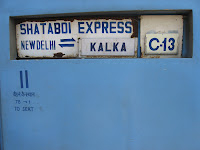News of the Indian world
In scanning Indian newspapers for health-related items, I often come across strange news. As an amendment to my last post, I must say the Baltimore Sun has never reported on girls forced to marry frogs.
2-yr-old falls into pit: A two- year old girl reportedly fell in an open deep pit in Samaipur Badli in outer Delhi on Sunday afternoon. According to the police, Payal was playing with her friends near the pit when she went missing..."A two-year-old girl is suspected to be inside a pit which is around 4 ft. deep. The rescue operation is still on. But chances of her survival are unlikely," said police. [Times of India, February 3
Man Assaults Wife Over Jeans: A man kicked and stamped his wife because she was dressed "as a man"... The police promptly dispatched the women, who suffered the battery in full public glare [in Dabwali market], to her in-laws, terming it as a "family matter." No case was filed.. [Hindustan Times]
Seven-year-old Indian girls 'marry frogs'
Two seven-year-old girls from a remote village in India have married frogs in a bizarre wedding ritual. The young ‘brides’, Vigneswari and Masiakanni, hail from the village of Pallipudupet in Tamil Nadu's Villupuram district. The wedding ceremony, a highlight of the annual Pongal (harvest) festival, was conducted to prevent the outbreak of mysterious diseases in the village. The girls wore traditional gilded saris and gold jewellery and married their amphibian grooms in front of hundreds of villagers. The frogs were tied to long sticks decorated with garlands for the lavish marriage ceremonies. The subsequent celebrations had all the usual elements of a traditional marriage including a sumptuous feast. [Times of India, January 29]
2-yr-old falls into pit: A two- year old girl reportedly fell in an open deep pit in Samaipur Badli in outer Delhi on Sunday afternoon. According to the police, Payal was playing with her friends near the pit when she went missing..."A two-year-old girl is suspected to be inside a pit which is around 4 ft. deep. The rescue operation is still on. But chances of her survival are unlikely," said police. [Times of India, February 3
Man Assaults Wife Over Jeans: A man kicked and stamped his wife because she was dressed "as a man"... The police promptly dispatched the women, who suffered the battery in full public glare [in Dabwali market], to her in-laws, terming it as a "family matter." No case was filed.. [Hindustan Times]
Seven-year-old Indian girls 'marry frogs'
Two seven-year-old girls from a remote village in India have married frogs in a bizarre wedding ritual. The young ‘brides’, Vigneswari and Masiakanni, hail from the village of Pallipudupet in Tamil Nadu's Villupuram district. The wedding ceremony, a highlight of the annual Pongal (harvest) festival, was conducted to prevent the outbreak of mysterious diseases in the village. The girls wore traditional gilded saris and gold jewellery and married their amphibian grooms in front of hundreds of villagers. The frogs were tied to long sticks decorated with garlands for the lavish marriage ceremonies. The subsequent celebrations had all the usual elements of a traditional marriage including a sumptuous feast. [Times of India, January 29]












 I watched the news of America's $170 million dollar inauguration preparations stream in from Indira Gandhi airport in Delhi, en route to Bangalore. My taxi driver had quoted me the figure in rupees when I told him it was a very important day for my country. "This very expensive day!" he pointed out, adding that he liked Obama and thinks he will work hard to make the world a better place. In clear agreement were the Kenyans dancing on IBN7 Hindi language news, which the producers cut to in between shots of Obama grinning in front of the YES WE CAN mantra.
I watched the news of America's $170 million dollar inauguration preparations stream in from Indira Gandhi airport in Delhi, en route to Bangalore. My taxi driver had quoted me the figure in rupees when I told him it was a very important day for my country. "This very expensive day!" he pointed out, adding that he liked Obama and thinks he will work hard to make the world a better place. In clear agreement were the Kenyans dancing on IBN7 Hindi language news, which the producers cut to in between shots of Obama grinning in front of the YES WE CAN mantra.

